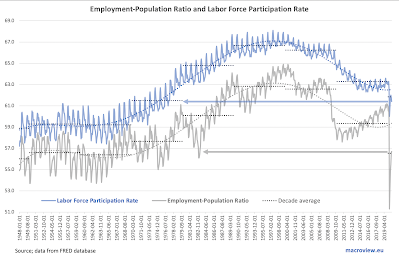One of thee major casualties of the COVID19 pandemic has been the U.S. labor market. However, with an allegedly robust recovery under way, we are seeing significant improvements across some metrics of labor markets health. In some, but not all.
Take labor force participation rate:
Let's consider this for a second. During the Great Recession and the Global Financial Crisis, the lowest LFP rate reached was 63.8. In the Dot.Com recession, that number was 65.9. In the 1990s recession it was 65.5. For the entire decade of the 1980s, the lowest reading for LFP rate was 63.0. In fact, the only decade with lower LFP rate than current is the decade of the 1970s. February 1977 was the last time we saw LFP rate at the level below September 2020 reading.
Things are marginally better for another measure of labor markets health: the Employment to Population Ratio (EPR), which currently sits at 56.7, lower than any recession reading prior to the COVID19 pandemic since the first recession of the 1980s. March 1983 was the last time we saw this reading until the COVID19 hit.
Give it a thought, folks, a 'historical recovery' is the one where there are just 567 people working (part time or full time. minimum wage or living wage) per each 1,000 working age adults. Or, described differently, an economy where only 614 working age adults our of 1,000 are either in employment or confident enough of their prospects for finding a job to bother searching for one.

No comments:
Post a Comment